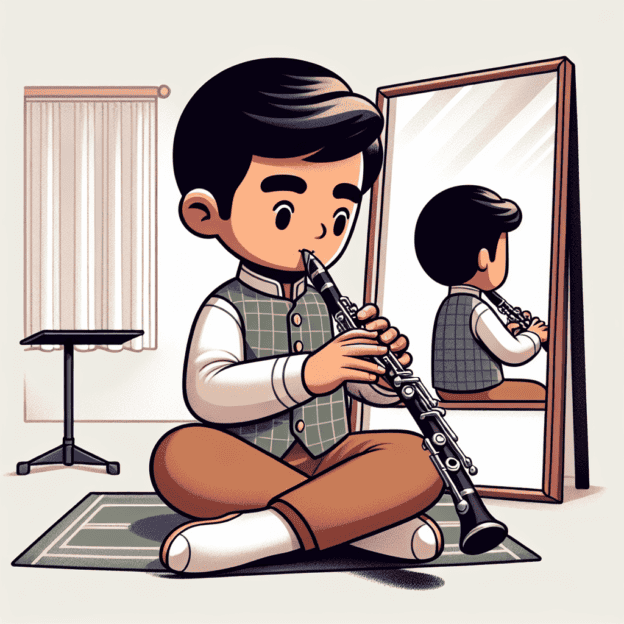Playing the clarinet requires more than just musical talent; proper technique is essential for producing a beautiful sound and maintaining comfort during practice and performance. One fundamental aspect that many beginners overlook is how to hold a clarinet properly. The way you position your hands, body, and the instrument can greatly affect your overall playing experience. Let's explore the key elements involved in holding a clarinet appropriately.
The Importance of a Good Grip
Having a solid grip on your clarinet is important for several reasons. It allows for better control over finger movements, helps prevent fatigue, and contributes to sound quality. If you don't hold your instrument correctly, you may struggle with finger coordination and even develop tension in your hands and arms, which can hinder your ability to play efficiently.
Proper Posture
Before you even bring the clarinet to your mouth, it's vital to establish proper posture:
- Sitting Position: If sitting, make sure your feet are flat on the ground, your back is straight, and your shoulders are relaxed. Avoid slouching, as a good upright posture allows for better breath support and control when playing.
- Standing Position: If standing, keep your weight evenly distributed on both feet. Stand tall with a slightly relaxed but upright posture. This will help you maintain stability when you lift the clarinet to play.
| Posture Type | Key Points |
|---|---|
| Sitting |
– Feet flat on the ground – Back straight – Shoulders relaxed – Avoid slouching |
| Standing |
– Weight evenly distributed – Stand tall – Slightly relaxed but upright posture – Maintain stability |
Hand Positioning
Now that you have optimal posture, let's focus on how to position your hands:
- Left Hand: The left hand is responsible for covering the upper tone holes. Curve your fingers gently and position them so that your thumb supports the back of the clarinet, specifically on the thumb rest. Your fingers should hover comfortably above the keys, ready to press down without excessive force.
- Right Hand: The right hand handles the lower keys. Position it similarly with curled fingers hovering above the keys. Ensure that your right thumb is also resting against the thumb rest, allowing for a steady grip as you maneuver between notes.
Finding the Balance
The clarinet should feel balanced when held. Tilt it slightly at an angle of approximately 45 degrees to your body. This position facilitates easier finger movement and allows for better projection of sound. If the clarinet feels heavy on one side, experiment with the placement of your fingers and thumbs to find the perfect balance.
Common Mistakes to Avoid
As with any instrument, maintaining proper technique can take time. Here are some common mistakes to watch out for:
- Tensing Up: Avoid gripping the clarinet too tightly. Tension in your fingers, hands, or arms can lead to discomfort and even injury over time.
- Incorrect Thumb Position: Make sure your thumbs are always resting on the thumb rests. This ensures a proper grip and allows you to retain control of the clarinet.
- Finger Misalignment: Always check that your fingers are positioned over the correct keys. Misalignment can lead to faulty fingerings and frustrating playing experiences.
Practice Techniques
To develop a comfortable grip and positioning when holding the clarinet, consider incorporating these practice techniques:
- Mirror Practice: Use a mirror to observe your posture and hand position while playing. This can help you identify areas for improvement.
- Hold Without Playing: Spend time simply holding the clarinet and adjusting your grip. Experiment with different positions and angles—be sure to practice these cuts each time you play.
- Warm-Up Exercises: Incorporate stretching and warming up exercises for your hands and fingers before playing. This will encourage flexibility and reduce tension.
Quick Tips for Proper Clarinet Holding
- Keep your wrists straight and relaxed
- Maintain a gentle curve in your fingers
- Use thumb rests for support
- Distribute weight evenly between both hands
- Practice regularly to build muscle memory
The Role of Instrument Quality
An often-overlooked aspect of holding the clarinet properly is the quality of the instrument itself. High-quality clarinets, such as those crafted by brands like Martin Freres, tend to be ergonomically designed for comfort and ease of play. Investing in a well-made instrument can help facilitate the right posture and positioning, allowing you to practice and perform with maximum enjoyment.
When shopping for a clarinet, test different models to see which one feels best in your hands. Look for one that provides a good balance and is comfortable to hold for extended periods.
Embracing a proper grip and positioning is a journey that requires patience and consistent practice. Keep refining your technique, and remember that as your skills progress, you will find your own unique style of holding the clarinet.
By paying attention to how you hold your clarinet, you set the stage for successful music-making, allowing your talent to shine through and creating a fulfilling musical experience.







